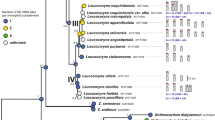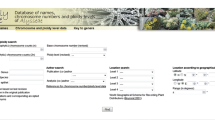Abstract
Continuing cytotaxonomic research in the generaCyamopsis andIndigofera, this time with attention payed for the greater part to East Tropical African species yielded the following results:
-
1.
Except for four rather small subsections ofIndigofera proper and the related genusRhynchotropis Harms, information was obtained about all Taxa. Of the 283 species described inGillett'ss monograph, some 80 species, among them a few with subspecies and varieties, now have been cytologically examined.
-
2.
All through both generaCyamopsis andIndigofera there exists a diversity in dimensions and types of chromosomes which usually does not appear to be consistent with the accepted taxonomical classification.
-
3.
Nevertheless,Cyamopsis thus far is characterized by2n=14 chromosomes, whereas2n=16 chromosomes is the most common number inIndigofera. On the other hand the sectionIndigastrum of the latter genus uniformly has2n=14 chromosomes, strengthening the supposition that this section may be closely related toCyamopsis.
-
4.
The speciesI. macrocalyx Guill. & Perr. classified in thePaniculatae has2n=12 chromosomes. The speciesI. emarginella Steud. exA. Rich. classified in theTinctoriae has2n=24, favouring the suggestion that the 48-chromosome Himalayan and East-Asiatic shrubbyIndigofera's may not be hexaploids with base numberx=8, but octoploids in anx=6 range.
-
5.
Polyploidy in thex=8 range, such as2n=32 seems to be fairly common all through the genusIndigofera and occurs, perhaps, more in the widely-spread African-Asiatic-(American) sections and subsections than in the African endemic taxa. In some cases the habitat of these polyploids appeared to be in higher altitudes and/or under less favourable climatic conditions.
-
6.
The occurrence of giant chromosomes in the number2n=8 inI. richardsiae Gillett points to a new base number ofx=4 in theLeguminosae and suggests that theGaleaeae may be considered as a very old group. The2n=16 plants, consequently, must be taken as tetraploids.
-
7.
Implications as to evolutionary relationship in theIndigofera and adjacent genera for the present appear to be impossible on the basis of cytotaxonomy. At most may be suggested that an intricate polyphylesis lies at the roots of theGalegeae and its genera.
Similar content being viewed by others
References
Chuang, T. I., C. Y. Chao, W. W. L. Hu &S. C. Kwan (1963). Chromosome numbers of the vascular plants of Taiwan I.Taiwania 1:51–66.
Frahm-Leliveld, J. A. (1960). Observations on chromosomes in the genusIndigofera L.Acta Botanica Neerlandica 9:286–293.
Frahm-Leliveld, J. A. (1962). Further observations on chromosomes in the genusIndigofera L.Acta Botanica Neerlandica 11:201–208.
Gillett, J. B. (1958).Indigofera (Microcharis) in Tropical Africa with the related generaCyamopsis andRhynchotropis.Kew Bulletin. Additional Series I: pp. 166.
Hagerup, O. (1932). Über Polyploidie in Beziehung zu Klima, Oekologie und Phylogenie. Chromosomenzahlen aus Timbuktu.Hereditas 16:19–40.
Hymowitz, T. &M. D. Upadhya (1963). The chromosome number ofCyamopsis serrata Schinz.Curr. Sci. 32:427–428.
Index to Plant Chromosome numbers for 1964. (1965). The University of North Carolina Press: p. 424.
Kawakami, J. (1930). Chromosome numbers in theLeguminosae.Bot. Mag. Tokyo 44:319–328.
Kishore, H. (1951). A note on the chromosome numbers of some plants.Indian J. Genetics 11:217.
Kreuter, E. (1930). Beitrag zu Karyologisch-systematischen Studien an Galegeen.Planta 11:1–44.
Miège, J. (1960). Troisième liste de nombres chromosomiques d'espèces d'Afrique occidentale.Annales Fac. Sci. Univ. Dakar 5:75–86.
Pritchard, A. J. &K. F. Gould (1964). Chromosome numbers in some introduced and indigenous legumes and grasses.Div. Trop. Pastures Tech. Pap. 2 (C.S.I.R.O., Australia) pp. 18.
Ramanathan, K. (1955). Chromosome numbers in Indian desert plants.Curr. Sci. 24:17.
Sampath, S. &K. Ramanathan (1949). Chromosome numbers in Indian economic plants. III.Curr. Sci. 18:408–409.
Senn, H. A. (1938). Chromosome number relationships in theLeguminosae.Bibl. Genetica 12:175–345.
Shibata, K. (1962). Estudio citológico de plantas colombianas silvestres y cultivadas.J. Agric. Sci. Tokyo Nogyo Daigaku 8:49–62.
Simmonds, N. W. (1954). Chromosome behaviour in some tropical plants.Heredity 8:139–146.
Turner, B. L. (1956). Chromosome numbers in theLeguminosae I.Am. J. Bot. 43:577–581.
Turner, B. L. &O. S. Fearing (1959). Chromosome numbers in theLeguminosae. II: African species, including phyletic interpretations.Am. J. Bot. 46: 49–57.
Turner, B. L. (1960). Chromosome numbers in theLeguminosae. III: Species of the South Western United States and Mexico.Am. J. Bot. 47:603–608.
Author information
Authors and Affiliations
Rights and permissions
About this article
Cite this article
Frahm-Leliveld, J.A. Cytotaxonomic notes on the generaIndigofera L. andCyamopsis DC.. Genetica 37, 403–426 (1966). https://doi.org/10.1007/BF01547145
Received:
Issue Date:
DOI: https://doi.org/10.1007/BF01547145




